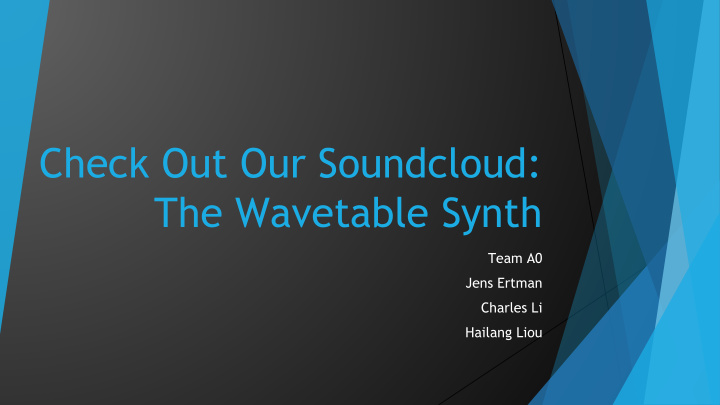



Check Out Our Soundcloud: The Wavetable Synth Team A0 Jens Ertman Charles Li Hailang Liou
The Problem Software Synthesizers ● ○ Interesting wave manipulation features ○ Trapped in computer audio environments Hardware Synthesizers ● ○ Cheap and missing core wave manipulation features ○ Expensive with full feature set Our Synthesizer ● ○ FPGA based ○ Wave Blending/Shaping ○ Features/effects of less expensive synths ○ Core features of more expensive synths
Solution Approach Wavetable Analog Digital DAC Audio MIDI Synthesis and Effects, Effects Output Output Keyboard Shaping EQ Input MIDI Created on FPGA Message Decoder Adjust Wavetable Analog circuitry
Complete Solution
Complete Solution MIDI message receiver/decoder Wavetable address calculator Wavetable access Envelope generator Mixer Effects chain (distortion, delay, reverb)
Complete Solution
Additions from the Design Review Reverb overhaul ● Redesign balancing accuracy and device ○ resource usage Envelope generators (ADSR) ● Shape the tone over time ○ Drum synthesis on FPGA board buttons ● Four drum kit (snare, bass, hats, toms) ○ Made with triangle waves and white noise ○
Metrics and Validation Requirement Testing Method Passing Behavior Effects Testbenches Correct outputs for all given test vectors Note pitch Off the shelf instrument tuner <5 cents out of tune Distortion Frequency domain measurements <5% total power as of a single sine wave harmonics Frequency Compare the output levels of all <5% deviance output level Response notes Filters Generate Bode plots <5% away from ideal -3dB cutoffs
Metrics and Validation Requirement Test Result Pass? Effects Testbenches behaved as expected, output correct Y values according to model Note pitch All notes in tune, smallest deviation at 0.1 cents, Y greatest deviation at 4.4 cents Distortion Not including ground noise all other noise is down N 40db from the peak of the note Frequency Response Note volumes are within 5% of each other until N the last 8 piano notes (A0-E1) Filters Cutoffs were as expected, smallest deviation at Y 0.5%, greatest at 3.8%
Additional metrics FPGA Area ● ○ ~10% of FPGA used, 5k Logic Elements ○ 1.3 Mb of block RAM used, mostly for delay and reverb effects ○ 100% embedded multiplier usage, plus some multipliers in LEs (integer) Power Consumption ● ○ 18.25mA from 5V power supply for analog circuitry 91.25mW ○ 18.34mA from 2.5V power supply for DAC output circuitry 45.85mW ○ 3.21mA from 5V FPGA voltage rail 16.05mW ○ 59.71mA from 5V wall outlet for FPGA 298.55mW ○ Total power 451.7mW
Project Management Necessary work Extra features in progress ● ● ○ Clear up 60Hz harmonics noise ○ Recording and looping of short snippets ○ Final Polish ○ Simple FM synthesis
Lessons Learned Digital to analog interface is messier than it seems ● Be careful with your grounds ● Don’t underestimate integration complexity ● Important for multiple people to understand each part ●
Recommend
More recommend